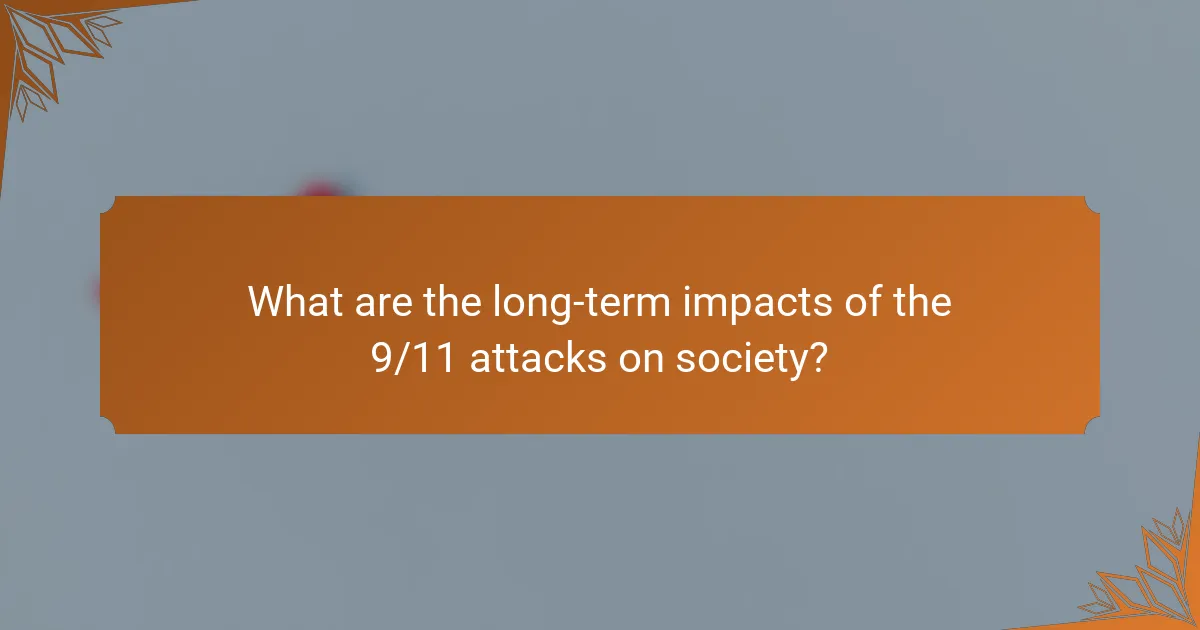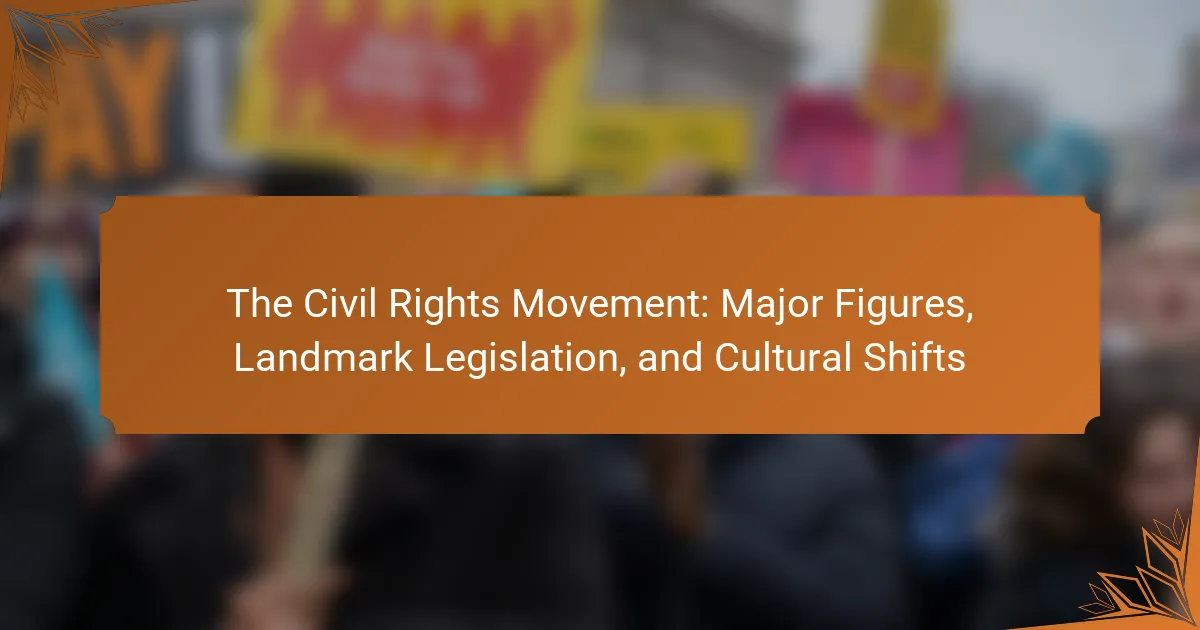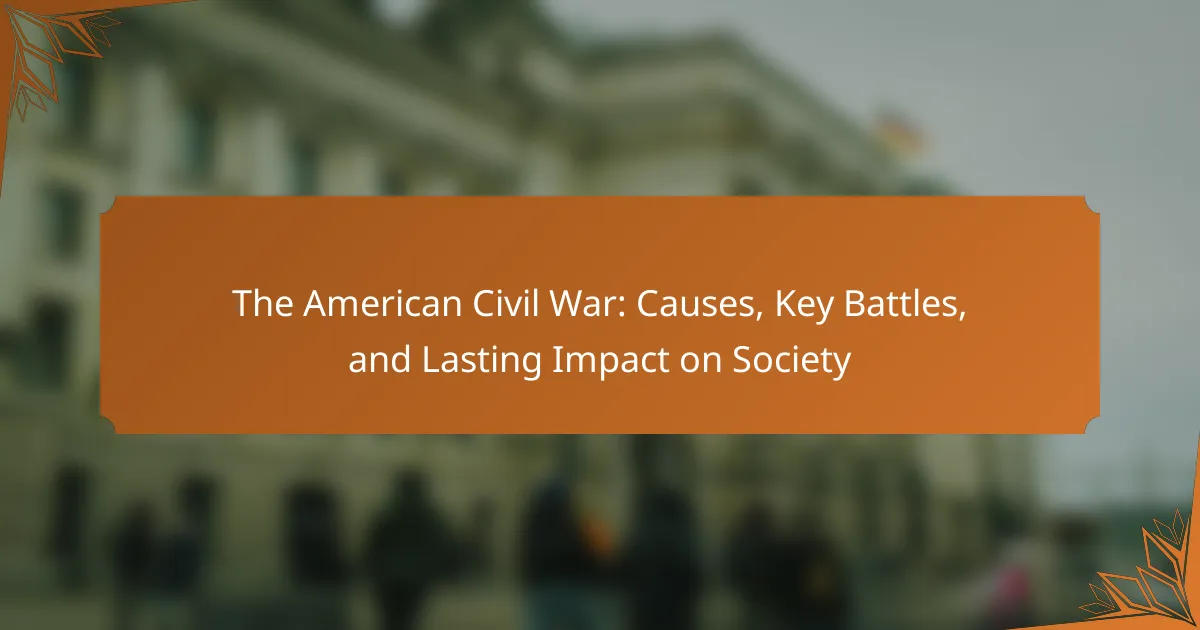The 9/11 attacks refer to a series of coordinated terrorist actions carried out on September 11, 2001, by al-Qaeda operatives, resulting in the hijacking of four commercial airplanes. Two planes were flown into the Twin Towers of the World Trade Center, while a third struck the Pentagon, and the fourth crashed in Pennsylvania after passengers attempted to regain control. These attacks led to nearly 3,000 fatalities and prompted significant changes in U.S. national security policies, including the establishment of the Department of Homeland Security and the enactment of the USA PATRIOT Act. The aftermath of 9/11 also saw increased surveillance, a rise in Islamophobia, and a shift in U.S. foreign policy, particularly regarding military operations in Afghanistan. The article explores the timeline of events, national security changes, and global reactions stemming from this pivotal moment in history.

What were the key events of the 9/11 attacks?
The key events of the 9/11 attacks began on September 11, 2001. Four commercial airplanes were hijacked by terrorists associated with al-Qaeda. Two planes were flown into the Twin Towers of the World Trade Center in New York City. The first plane struck the North Tower at 8:46 AM. The second plane hit the South Tower at 9:03 AM. A third plane crashed into the Pentagon at 9:37 AM. The fourth plane, United Airlines Flight 93, was headed for a target in Washington, D.C. Passengers attempted to regain control, leading to its crash in Pennsylvania at 10:03 AM. The Twin Towers collapsed within hours, at 9:59 AM and 10:28 AM, respectively. These attacks resulted in nearly 3,000 deaths and significant global repercussions.
How did the attacks unfold on September 11, 2001?
On September 11, 2001, a series of coordinated terrorist attacks were carried out by the extremist group al-Qaeda. At 8:46 AM, American Airlines Flight 11 crashed into the North Tower of the World Trade Center in New York City. At 9:03 AM, United Airlines Flight 175 struck the South Tower. At 9:37 AM, American Airlines Flight 77 hit the Pentagon in Arlington, Virginia. At 10:03 AM, United Airlines Flight 93 crashed into a field in Pennsylvania after passengers attempted to retake control from hijackers. The attacks resulted in the collapse of both towers by 10:28 AM. Nearly 3,000 people were killed, making it the deadliest terrorist act in world history.
What were the locations targeted during the attacks?
The locations targeted during the 9/11 attacks were the World Trade Center in New York City and the Pentagon in Arlington, Virginia. The World Trade Center included both the North and South Towers. The attacks occurred on September 11, 2001. Four commercial airliners were hijacked by terrorists. Two planes were flown into the Twin Towers, causing their collapse. One plane crashed into the Pentagon, the headquarters of the U.S. Department of Defense. The fourth plane, United Airlines Flight 93, was headed for a target in Washington, D.C. but crashed in Pennsylvania after passengers intervened. These locations were chosen for their symbolic significance.
What were the immediate responses from emergency services?
Emergency services responded immediately to the 9/11 attacks by deploying first responders to the scene. Firefighters, police, and emergency medical personnel arrived quickly at the World Trade Center. They began evacuating civilians and conducting search and rescue operations. Emergency medical teams set up triage areas to treat the injured. Communication networks were established to coordinate efforts among various agencies. The Federal Aviation Administration ordered a nationwide grounding of aircraft. Hospitals were put on alert to prepare for incoming casualties. These actions were crucial in managing the chaos and providing assistance during the crisis.
What were the global reactions to the 9/11 attacks?
The global reactions to the 9/11 attacks were widespread and varied. Many countries expressed solidarity with the United States. Nations such as the United Kingdom and Canada offered condolences and support. Global leaders condemned the attacks as acts of terrorism. In the aftermath, numerous countries enhanced their security measures. The United Nations held an emergency meeting to address the situation. Public demonstrations of support for the U.S. occurred worldwide. Some nations also faced increased scrutiny regarding their own security policies. Overall, the attacks significantly shaped international relations and counter-terrorism efforts.
How did world leaders respond to the attacks?
World leaders condemned the 9/11 attacks and expressed solidarity with the United States. Many offered condolences and support for the victims. Countries around the world held vigils and memorials. NATO invoked Article 5 for the first time, stating an attack on one is an attack on all. Several leaders pledged military support in the fight against terrorism. International cooperation on intelligence and security increased significantly. Nations enacted stricter security measures to prevent similar attacks. Global public opinion largely united in support of the U.S. response.
What was the public reaction in the United States and worldwide?
The public reaction to the 9/11 attacks in the United States was one of shock and grief. Many Americans expressed their sorrow through memorials and vigils. There was a surge in patriotism, with people displaying flags and supporting first responders. Worldwide, reactions included solidarity with the U.S. and condemnation of terrorism. Many countries held memorial services and offered condolences. Global protests against terrorism emerged, reflecting widespread support for the U.S. response. The attacks significantly impacted international relations and security policies globally.

How did the 9/11 attacks change national security policies?
The 9/11 attacks significantly changed national security policies in the United States. The attacks led to the establishment of the Department of Homeland Security in 2003. This department consolidated various agencies to improve coordination and response to threats. The USA PATRIOT Act was enacted shortly after the attacks. This act expanded surveillance and law enforcement powers to prevent terrorism. Airport security underwent major overhauls, including stricter screening processes for passengers and luggage. Intelligence sharing between agencies was enhanced to prevent future attacks. The focus shifted to counterterrorism strategies both domestically and abroad. These changes aimed to create a more proactive approach to national security.
What new laws and regulations were enacted after the attacks?
The USA PATRIOT Act was enacted in response to the 9/11 attacks. This law significantly expanded the government’s surveillance powers. It allowed for increased wiretapping and monitoring of communications. The act also facilitated information sharing between agencies. Additionally, the Homeland Security Act was passed, creating the Department of Homeland Security. This department consolidated various federal agencies to better coordinate national security efforts. The Enhanced Security Measures were implemented at airports and public spaces. These measures included stricter screening processes and increased security personnel. These laws and regulations aimed to prevent future terrorist attacks and enhance national security.
How did the USA PATRIOT Act alter surveillance practices?
The USA PATRIOT Act significantly expanded surveillance practices in the United States. It allowed law enforcement agencies to conduct wiretaps and monitor electronic communications more easily. The Act enabled the FBI to access personal records held by third parties without a warrant. Additionally, it broadened the definition of terrorism and related activities. This led to increased information sharing between government agencies. The Act also authorized roving wiretaps, allowing surveillance on multiple devices used by a suspect. These changes aimed to enhance national security following the 9/11 attacks. The alterations raised concerns about civil liberties and privacy rights among citizens.
What changes occurred in airport security protocols?
Airport security protocols underwent significant changes after the 9/11 attacks. The Transportation Security Administration (TSA) was established in November 2001 to oversee security. Passengers are now required to remove shoes, belts, and light jackets during screening. Liquid restrictions were implemented, limiting containers to 3.4 ounces. Full-body scanners and advanced imaging technology were introduced to detect concealed items. Enhanced passenger screening procedures, including random checks, became standard. These changes aimed to improve safety and prevent future attacks. Statistics show a decrease in security breaches since these measures were enacted.
How did the attacks influence military strategies and operations?
The 9/11 attacks significantly influenced military strategies and operations. The United States shifted its focus to counterterrorism as a primary objective. This led to the implementation of the Global War on Terror. Military operations became more focused on unconventional warfare. The U.S. initiated invasions of Afghanistan and Iraq. These actions aimed to dismantle terrorist networks and regimes that supported them. Intelligence gathering and surveillance increased dramatically in military operations. The attacks prompted a reevaluation of national security policies and military readiness.
What was the rationale behind the War on Terror?
The rationale behind the War on Terror was to combat terrorism following the September 11, 2001 attacks. The U.S. government aimed to eliminate terrorist organizations that posed a threat to national security. This included targeting al-Qaeda and the Taliban in Afghanistan. The attacks resulted in nearly 3,000 deaths, prompting a strong military response. The U.S. sought to prevent future attacks by dismantling terrorist networks. Additionally, the rationale included promoting democracy in the Middle East. The belief was that democratic governance could reduce the appeal of extremism. This led to prolonged military engagements in Afghanistan and Iraq.
How did the U.S. military’s approach to foreign policy change?
The U.S. military’s approach to foreign policy changed significantly after the 9/11 attacks. The attacks prompted a shift from traditional deterrence strategies to preemptive action. This new approach emphasized military intervention to counter perceived threats before they could materialize. The U.S. initiated the War on Terror, leading to military operations in Afghanistan and Iraq. These interventions aimed to dismantle terrorist networks and promote regime change. Additionally, the military adopted a more integrated strategy with intelligence agencies. This integration aimed to enhance the effectiveness of operations against global terrorism. The focus shifted from state-centric threats to non-state actors. This change reflected an evolving understanding of security in a globalized world.

What are the long-term impacts of the 9/11 attacks on society?
The long-term impacts of the 9/11 attacks on society include heightened security measures and increased surveillance. Following the attacks, the U.S. government implemented the USA PATRIOT Act in 2001. This act expanded law enforcement’s surveillance capabilities. It aimed to prevent future terrorist attacks.
Socially, there was a rise in Islamophobia and discrimination against Muslim communities. A study by the Pew Research Center indicated that negative views of Muslims increased significantly post-9/11. Economically, the travel and airline industries faced long-lasting effects. The 9/11 attacks led to a decline in air travel and increased security costs.
Additionally, the attacks influenced U.S. foreign policy significantly. The U.S. launched military operations in Afghanistan to dismantle al-Qaeda. This led to prolonged military engagement in the region. Overall, the 9/11 attacks reshaped national security, societal attitudes, and foreign policy for years to come.
How have perceptions of safety and security evolved since 9/11?
Perceptions of safety and security have significantly shifted since 9/11. Initially, there was a heightened sense of vulnerability in the United States. The immediate aftermath saw increased security measures at airports and public spaces. The introduction of the USA PATRIOT Act expanded government surveillance capabilities. Public trust in government to ensure safety increased, but concerns about civil liberties emerged. Over time, fear of terrorism has led to normalization of security protocols. Awareness of cybersecurity threats has also grown, reflecting a broader understanding of safety. Recent events, like mass shootings, have further complicated perceptions of security. Overall, the evolution reflects a complex balance between safety and personal freedom.
What role does fear play in public policy and personal behavior?
Fear significantly influences public policy and personal behavior. It drives policymakers to prioritize national security measures. For example, the aftermath of the 9/11 attacks led to the implementation of the USA PATRIOT Act. This legislation expanded surveillance and law enforcement powers in response to perceived threats. Public fear also affects individual behavior, often leading to increased vigilance and changes in daily routines. Studies show that fear can result in heightened support for government interventions. Consequently, fear can create a cycle where perceived threats lead to more stringent policies, further influencing public sentiment and behavior.
How has the narrative around terrorism shifted in media and culture?
The narrative around terrorism in media and culture has shifted significantly since the 9/11 attacks. Initially, media coverage focused on immediate fear and the portrayal of terrorists as faceless enemies. Over time, narratives have evolved to include discussions on the root causes of terrorism, such as political and social grievances. This shift has led to a more nuanced portrayal of individuals involved in terrorism.
Cultural representations have also changed, moving from simplistic depictions to more complex characters in films and literature. The post-9/11 era saw increased scrutiny of government policies and their impact on civil liberties. Documentaries and investigative journalism have explored the consequences of war on terror.
Public discourse now often emphasizes the need for understanding and addressing the underlying issues that lead to radicalization. This evolution reflects a broader recognition of the complexities surrounding terrorism and its impact on society.
What lessons can be learned from the 9/11 attacks?
The lessons learned from the 9/11 attacks include the importance of national security, emergency preparedness, and international cooperation. National security measures were significantly strengthened post-9/11. The creation of the Department of Homeland Security in 2002 exemplifies this commitment. Emergency response protocols were reevaluated and improved to enhance readiness for future crises. The attacks highlighted the need for better intelligence sharing among agencies. This led to reforms in how information is disseminated within and between governments. Additionally, the global response showed the necessity for international collaboration in combating terrorism. Countries united in efforts to prevent similar attacks. These lessons emphasize the ongoing need for vigilance and adaptability in security practices.
How can societies improve resilience against future attacks?
Societies can improve resilience against future attacks by enhancing intelligence sharing and cooperation among agencies. Strengthening community engagement fosters trust and communication. Training first responders ensures a quick and effective response to incidents. Implementing robust cybersecurity measures protects critical infrastructure. Conducting regular drills prepares citizens for emergency situations. Investing in mental health support aids recovery from trauma. Research shows that societies with strong social networks recover faster from crises. For instance, communities with active neighborhood watch programs report lower crime rates and increased safety.
What best practices can be adopted for emergency preparedness?
Best practices for emergency preparedness include creating an emergency plan, conducting regular drills, and assembling an emergency kit. An emergency plan should outline procedures for various scenarios, including evacuation routes and communication strategies. Regular drills help individuals and organizations practice their responses, ensuring they are familiar with the plan. An emergency kit should contain essential supplies, such as food, water, first aid items, and important documents. According to FEMA, having a well-stocked kit can significantly improve survival chances during emergencies. Additionally, staying informed about local hazards and resources is crucial for effective preparedness. Engaging with community resources can also enhance overall readiness.
The 9/11 attacks represent a pivotal moment in history, marked by a series of coordinated terrorist actions on September 11, 2001, resulting in nearly 3,000 deaths and significant global repercussions. The article outlines the timeline of events, including the hijacking of four commercial airplanes and their subsequent targets: the World Trade Center and the Pentagon. It also examines the immediate responses from emergency services, the global reactions, and the long-term impacts on national security policies, including the establishment of the Department of Homeland Security and the enactment of the USA PATRIOT Act. Furthermore, the article discusses the evolution of public perception regarding safety, the narrative surrounding terrorism in media, and the lessons learned for future resilience against attacks.



